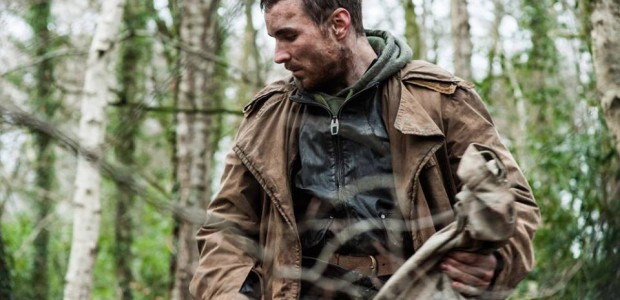
With the current trend towards post-apocalyptic cinema – both as big-budget spectacle and independent character studies – you would be forgiven for thinking you’ve seen it all. Hollywood has destroyed our planet through disease, ecological disasters, acts of war, and even – especially – the reanimated dead. If any visuals could possibly indicate the dwindling nature of humanity, then odds are some enterprising young filmmaker has committed it to camera.
I’m willing to bet, though, that you’ve never seen humanity killed through a single red line.
THE SURVIVALIST opens on a large section of red; for a few moments we think that a new production company logo has been introduced, until finally the camera pull back to reveal white dates against a black background. The red is revealed to be a graph line, representing the population of Earth; as we move into the 21st century, the line angle becomes steeper and stepper, and then it crashes. Over a painfully short period of time, the line dives down the screen, tapering off towards the bottom border until only the black background remains. We never know the precise population numbers or the cause of the crash, but we don’t need to. The lack of red explains it all.

This simple visual sets the tone for THE SURVIVALIST, a film that manages to summarize an entirely new human condition through the actions of three people. The survivalist (Martin McCann) lives by himself, a man who plants his own crops and knows everything about the plants and animals in his surrounding woods. Despite his fortified position, the man is careful; most of the world is viewed down the barrel of his shotgun, and most of his camp is surrounded by traps and alarms. One morning, the survivalist opens the door to find Kathryn (Olwen Fouéré) and Milja (Mia Goth), a mother and daughter who roam the land in search of food. Kathryn offers the survivalist seeds in exchange for part of his crop and he refuses; it is only when Milja is offered that the survivalist accepts, bringing the two women into his home and forging an uneasy alliance between hardened survivors. “There’s more than enough,” Kathryn tells the man. “That’s what they all thought,” the survivalist replies.
With little more than the inside of the survivalist’s cabin and the mounds of dirt in his garden, writer-director Stephen Fingleton is able to create a rich universe for his characters to inhabit. Each inch of the survivalist’s land serves a utilitarian purpose; all of his land has been neatly divided up among food, waste disposal, and traps against invaders. With utility and scarcity driving the decision-making of his characters, Fingleton is also careful in how he introduces other creative elements. Each of his actors takes multiple turns naked in front of the camera, but owing to the pragmatism of Fingleton’s future, there is very little elicit thrill in the act of looking, merely the functions – pleasurable or otherwise – of the human body. Much more exciting for both audience and characters are the few moments of music from the film’s naturalistic soundtrack. Milja occasionally fiddles with the survivalist’s harmonica and silverware, creating musical notes amidst the silence.

Many people – even admirers of the film – will refer to THE SURVIVALIST as a bleak thriller, but that does not quite ring true. We identify bleakness only where hope or optimism has been undermined; in THE SURVIVALIST, each character has adapted fully to the demands of the new world. Milja cannot be seen as a victim when she is the one to encourage the trade of sex for food; Kathryn cannot be a monster for her thoughts of betrayals when the survivalist himself has done worse to stay alive. What makes THE SURVIVALIST such a powerful film is the ways in which these relationships evolve due to, not in spite of, the moral relativism at the heart of the film.
Consider the scene where the three survivors first meet. The survivalist brings Milja and Kathryn into his shed and frisks them. There is no sexual pleasure taken in the act by the survivalist, and no anger or shame on display for the women. All three characters have gone through these motions before. The survival instinct is so dominant in this new society that it has become almost instinctual. The survivalist carefully places his rifle on a cloth tarp and drags it alongside him as he works in the garden; Kathryn plots to steal the shells to the rifle from the man’s pocket. These actions are performed absent emotion. Trust manifests itself as trying to kill someone else first.

In its own way, THE SURVIVALIST is a film about evolution, not annihilation. Many post-apocalyptic films are rooted in contemporary values, presenting sentiment as something to either preserve or root out in the quest for survival. Few films display characters as pragmatic as those in Fingleton’s film. Much like the red line in the film’s opening sequence, we are given only a small glimpse of the broader context, but more than enough to realize that things have changed drastically. The economy of the storytelling stands in for the world at large; in our three survivors, we envision a series of exchanges occurring throughout the world between those who have enough to stay alive and those who don’t. Many of these films argue that there is more to life than just surviving; THE SURVIVALIST makes the compelling argument that surviving is, ultimately, enough.
— MATTHEW MONAGLE.

Tags: Martin McCann, Mia Goth, New York, Olwen Fouéré, Post-Apocalyptic Cinema, Screenings, Stephen Fingleton, Thriller


No Comments